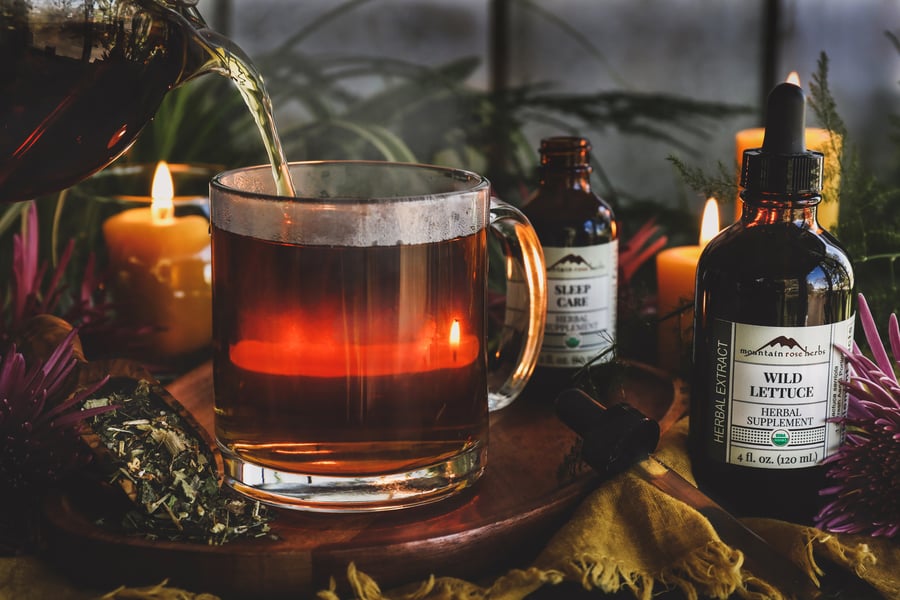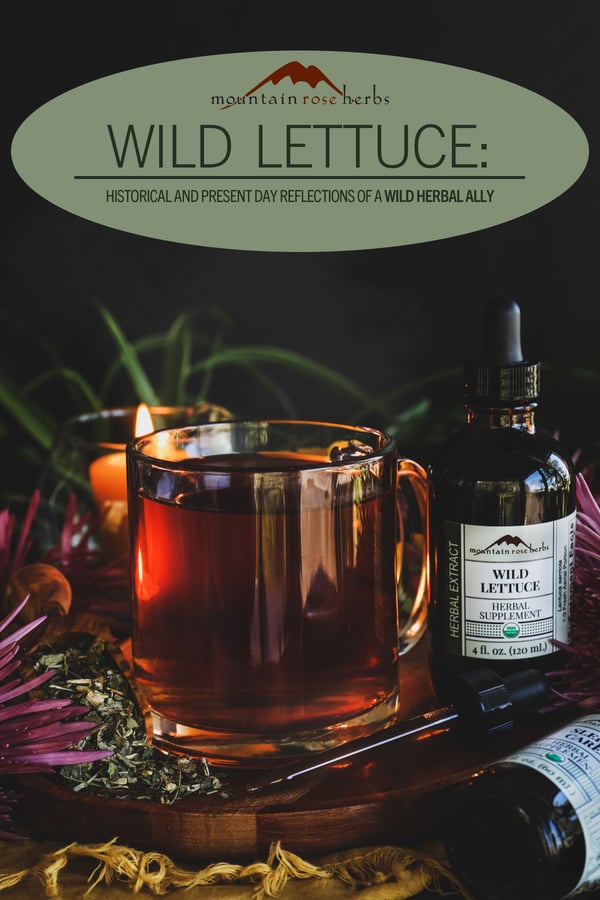Wild lettuce is one of those “weed” herbs that is fairly common throughout North America. Its cultivation origins are from Southern Europe. The plant has a long history of use as a nervine and a bitter and, as such, is grown in a variety of places in Europe to capture the beneficial constituents in its latex, leaves, and seeds. Wild lettuce has become naturalized in the United States, where it is now regularly wildharvested.
How to Identify Wild Lettuce
As the name suggests, wild lettuce is a woodland cousin of our common salad lettuce (Lactuca sativa). Lactuca spp. are members of the sunflower (Asteraceae) family. There are at least 10 species of wild lettuce that grow in North America, some of which are native and others that were introduced. All of the species exude what is known as lactucarium, a potent, milky latex that oozes out of the plant, and particularly the stems, when wounded or broken. Some varieties produce copious amounts of this latex, and because of this, have become the most sought after for health-supporting purposes. Lactucarium resembles the milky latex harvested from opium poppies and, similarly, can be reduced and dried into a thick solid. Hence the reason why the particularly potent varieties of Lactuca spp. found themselves being called lettuce opium in early pharmacopoeias.
Since there are a number of Lactuca species which are all commonly called "wild lettuce,” this is a plant that often requires the proper Latin name to correctly identify them in conversation. In general, however, wild lettuce is a bitter biennial herb with a smooth, erect stem that grows from a tap-root. The stem has some spiny or hairy prickles on the lower section and produces horizontal branches above. In some varieties, the green stem is spotted with purple. The stem itself has a few alternate, two-lobed, small leaves, but the upper branches produce many larger oblong leaves that can range from six to eighteen inches long. One of the most common varieties, Lactuca serriola, which is a species that was introduced in the U.S., also has spines along the vein on the underside of the leaves, so has come to be known as prickly lettuce. Lactuca varieties produce flowering heads and dark, dry fruit (achene) that vary in color by species.
Wild lettuces tend to like disturbed ground, so you can often find them on riverbanks, coastal areas, open land, and other places that experience some upheaval from the elements, animals, or humans. They can vary significantly in size; for instance, Lactuca virosa looks very similar to Lactuca serriola, but is much thicker and taller, growing as tall as seven feet.
Wildharvesters note that wild lettuce does have a number of look alikes, so it’s important to be 100% sure of the plant identity before harvesting. Looking for hairs along the underside of the leaf midrib is one good clue that you have found a true Lactuca species.
What Are the Benefits of Wild Lettuce?
There is evidence that Lactuca spp. was used in the ancient world for its cooling properties. Reportedly, the first Roman Emperor, Caesar Augustus (53 BCE - 14 CE) attributed his recovery from a severe illness to infusions of wild lettuce and, upon recovery, erected an altar and a statue in its honor. It was also listed in The Canon of Medicine, a five-book encyclopedia compiled by Persian physician-philosopher Avicenna, which was completed in 1025 CE and used into the 17th century.
Wild lettuce—particularly Lactuca virosa—was introduced in the U.S. as a health-supporting botanical as early as the 18th century and was added to the United States Pharmacopoeia (a compendium of drug information that is published annually) in 1898 for use in lozenges, tinctures, and syrups to soothe an irritated throat and chest conditions and to assist with sleep. Researchers discovered that other species of wild lettuce, while producing less quantity of lactucarium, could also be used similarly to the L. virosa species, and that the latex harvested from Lactuca serriola or Lactuca quercina was particularly potent.
How Do You Use Wild Lettuce?
Wild lettuce leaves and stems, lactucarium, and the oil from the seeds are all used medicinally. Leaves and stems are traditionally infused as tea or made into an extract. At Mountain Rose Herbs, we offer organic wild lettuce in bulk—expertly harvested and dried by our talented farm partner using the aerial portions of Lactuca virosa. We also make extract in small batches using fresh, organic Lactuca serriola. And, you will find wild lettuce in our Sleep Care Extract, blended with herbs traditionally used to encourage peaceful, restful sleep without a groggy feeling the next morning.
Because wild lettuce is a bitter, some people find it to be most palatable by taking it in water or juice, or blended with other high-flavor extracts like ginger, passionflower, or kava kava.
*These statements have not been evaluated by the Food and Drug Administration. These products are not intended to diagnose, treat, cure, or prevent any disease. We recommend that you consult with a qualified healthcare practitioner before using herbal products, particularly if you are pregnant, nursing, or on any medications. For educational purposes only.
Want to know more about our farm partners growing wild lettuce?
Read About Wild-Farmed Herbal Extracts from Oregon’s Willamette Valley
You may also enjoy:












